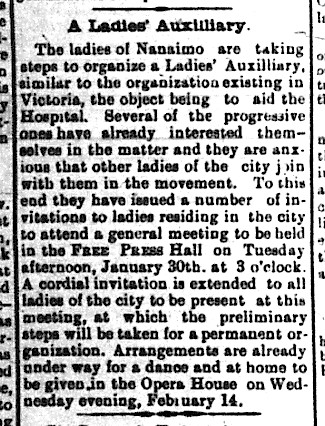1900 – 1920
In January, 1900, thirty women met to discuss the possibility of forming an Auxiliary to the Nanaimo Hospital. Their purpose was to raise funds to provide many of the necessities that the hospital lacked in a time when the government provided little funding for local healthcare. The list of members reflected the diversity of the community from the wives of miners to those whose husbands were in the professions.
During this era, before radio and TV, people created their own entertainments and it was mostly through this means that the Auxiliary raised their funds. They entered the social scene with an annual ball which became a highlight of the year. Concerts, teas, garden parties and theatrical were also held as fundraisers.
One of the first tasks of the Auxiliary was to undertake a good deal of the sewing for the hospital and provided many of the hospital supplies such as sheets, towels, basins, cutlery, nightgowns and personal supplies for patients. A group of members met with the Hospital Matron who supplied them with a list of needs every month. (Today, much sewing is still done weekly at the Auxiliary Craft Workshop where items are created for sale to raise funds for hospital equipment, and the Auxiliary still supplies donations to a number of departments for patient incidentals.)
Annual Tag Days raised several hundred dollars to assist Auxiliary work. By careful investment of their funds, the Auxiliary was able to establish a good bank balance and in 1913 were able to make a loan of $800 to the hospital to meet pressing bills.
1920’s, 30’s and 40’s
In the late ‘20’s, when the new hospital was being planned, the Auxiliary gathered over time some $20,000 by various activities to assist with the building. Patients had to be fed and the cupboards were often nearly bare. The hospital larder and linen room benefitted through the “Pantry” and “Towel” showers that were given by the Auxiliary in the ‘30’s and ‘40’s to help stock the shelves. The Auxiliary continued its good work during World War II, keeping supplies coming. Admission to the afternoon teas, held regularly at members’ homes, was often by donation of a piece of linen for the hospital.
1950’s and 60’s
A big seller in the 1950’s was the Women’s Auxiliary Cookbook – still used by many families in Nanaimo. It contained the first known printed recipe of the legendary “Nanaimo Bar” (A new cookbook issued recently has also been a great seller!).
When Chinatown burned in 1960, the Hospital Auxiliary was quickly on site helping to assist with feeding the dispossessed.
Expansion of the Auxiliaries: In 1959-60, as the hospital demands for help grew, new Auxiliaries to NRGH were formed in Mount Arrowsmith, Lantzville and Cedar. A Council of Auxiliaries was set up to work on joint projects, with each Auxiliary sending several Executive members to quarterly Council Meetings. (Over the years, the other three Auxiliaries have gradually been re-absorbed into the Nanaimo Auxiliary. The Council was disbanded in 1994.)
In 1961, to support an increasing staff workload, the Auxiliary was invited to form a Hospital Volunteer Service with Auxilians and others helping patients in the hospital. Volunteers played a large part in helping to move patients from the old Hospital on Kennedy Street to the present one when it opened in 1963. The first service developed under the leadership of the first Director of Volunteers, Kay Martin, was Admitting Hostess. By the time Mrs. Martin retired in 1966, there were 12 volunteer services operating and the Volunteer Service has continued to grow as more needs and opportunities presented themselves.
In 1967, a younger group of volunteers, the Candy Stripers was formed, and the Auxiliary continues to support the ‘Junior Volunteer’ program today by offering bursaries, assisting with funding for conferences and providing adult volunteers to help supervise the program.
1970’s, 80’s and 90’s
The opening of Dufferin Place Extended Care (now Residential Care) Facility in the late ‘80’s provided an opportunity for the Auxiliary to look at other ways for the community to add to the quality of life for patients and residents.
In 1987, the Auxiliary and Volunteer Services worked together to expand their services to ‘patients’ still at home in the community with the development of the Lifeline Emergency response system which connects clients with help in an emergency 24 hours a day. The Auxiliary eventually transferred management of this service to the Hospital Foundation as the Auxiliary turned its attention to other projects. Today, Lifeline provides service to more than 1300 clients in the Central Vancouver Island area.
Recent Years
As pressures for additional patient care space in the hospital grew, the two Auxiliary Gift Shops at opposite ends of the current hospital building were amalgamated into one larger shop in the Main Lobby. The Shop was refurbished in 2007/2008 and continues to offer a wide variety of gifts and sundries to staff, visitors and patients, in a bright and friendly environment. The Gift Shop continues to be one of the Auxiliary’s major fundraisers.
In 2005, the Auxiliary expanded its fundraising efforts back out into the community with the opening of a very successful Thrift Store in the Northridge Village Mall on Turner Road. With the opening of the Thrift Store, Auxiliary membership almost doubled with many other men and women wanting to help the hospital through this new project.
Such has been the success of the Thrift Store in Northridge that it has expanded and moved twice, but always in Northridge. As a result, our donations to our hospital and its departments consistetly increase each year, with a million dollar donation in 2025.
In 2015, the Auxiliary elected its first male president, which was testimony to the growing number of male volunteers in the organisation.

